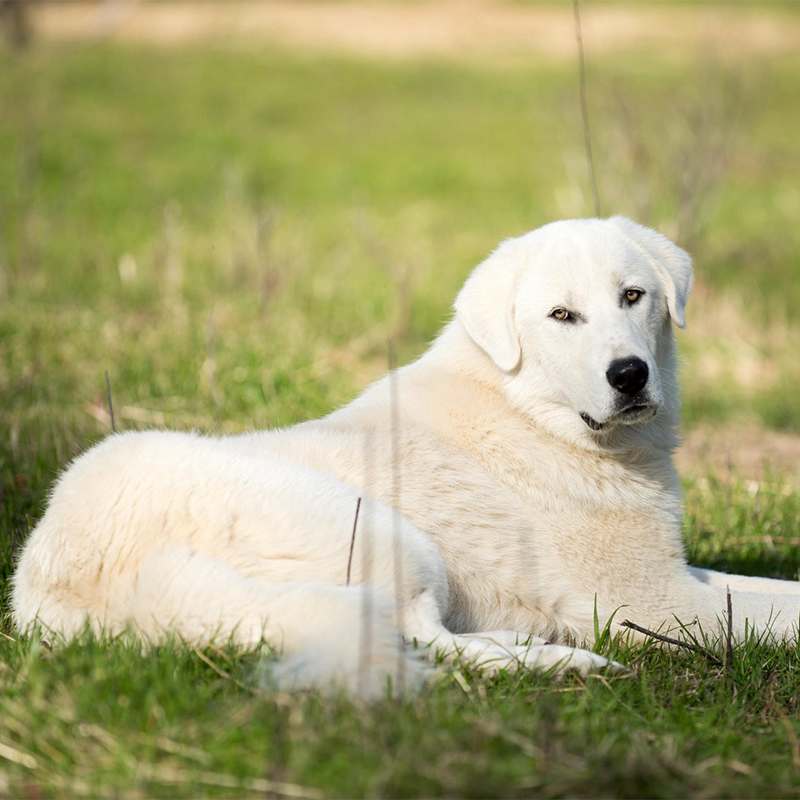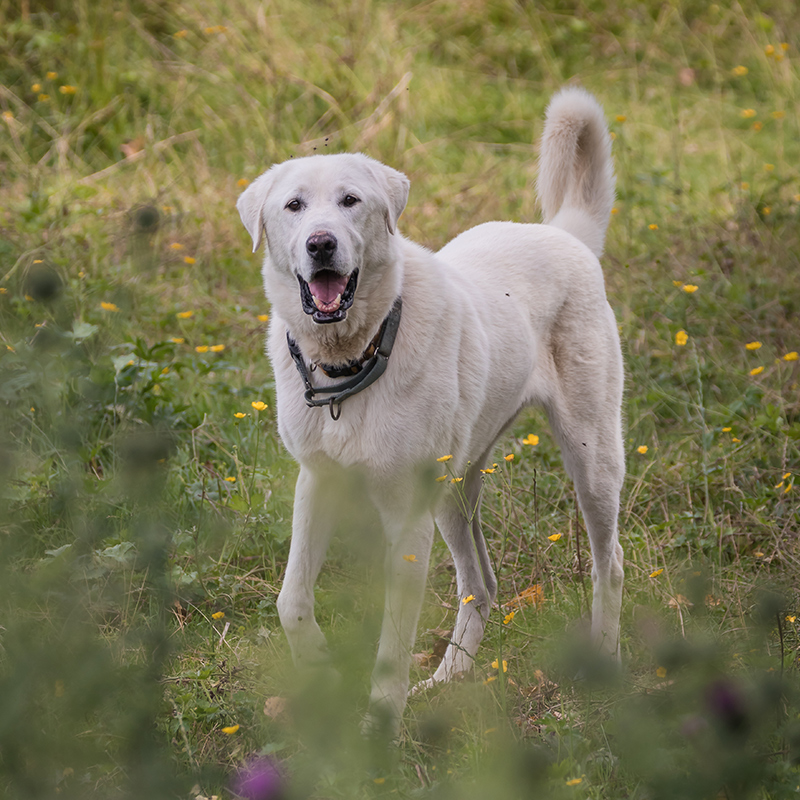
Akbash Dog
The Akbash Dog is a courageous, quiet, calm breed. These gentle giants make reliable guardians and loyal family companions.
Interested in discovering if your dog is an Akbash Dog?
Check out Wisdom Panel's DNA tests.

Akbash Dog Traits
General Appearance
The Akbash Dog is a large, lean, muscular dog with an alert and regal appearance. These pups display a mix of Mastiff and gazehound characteristics that breeders have labored to maintain.
Coat and Coloring
Akbash Dogs come in both medium and long coat types. The medium coat lies flat and has a sleek appearance. Long-coated dogs have slightly wavy hair, a distinct ruff, and profuse feathering on the legs and tail.
Both varieties have a thick double coat composed of a dense undercoat and longer, coarse guard hairs. The coat's thickness varies depending on the climate.
Akbash Dogs always have white coats. But some have light biscuit or gray shading around their ears or in their undercoats.
Distinctive Physical Traits
Key features of the Akbash Dog include a wedge-shaped head with pendant ears, a deep chest, long legs, and a long tail that curls over the back to show excitement. Males are typically taller and heavier than females, who have a notably feminine appearance.
Akbash Dog Temperament
True to their guard dog roots, Akbash Dogs are loyal, brave, and steady. They're also fast enough to chase off predators and independent enough to assess and respond to potential threats without guidance from their people.
Despite their imposing size, Akbash are gentle dogs that make affectionate, calm companions. They get along well with kids and make excellent family pets. But they tend to be suspicious of strangers and may act aggressively when an unknown dog enters their territory. Early socialization helps these pups grow into well-mannered adult dogs.
Compared to many other breeds, Akbash mature slowly, so expect their "puppy phase" to continue into adulthood.

Akbash Dog History
The Akbash Dog is native to the mountains and plains of western Turkey. Though we don't know the breed's exact origins, experts agree it's ancient. Villagers bred these large white dogs to protect sheep from predators—something they still do today.
The Akbash Dog is considered a landrace breed that mostly remained in the western half of Turkey until the 1960s. David and Judy Nelson brought the first Akbash Dog to the United States in 1978 after falling in love with the breed while on an extended diplomatic assignment. The Nelsons ultimately imported dozens of Akbash, and these dogs became the foundation stock for the American breeding program.
The U.S. Department of Agriculture began using the Akbash as a livestock guardian in the 1980s. Though the breed is now well-known among livestock producers, it has yet to receive American Kennel Club recognition. The United Kennel Club, however, accepted the Akbash in 1998.
Akbash Dog Care
Nutrition
Akbash thrive on a high-quality diet that's appropriate for their life stage (e.g., puppy, adult, senior). They also benefit from foods formulated for large breeds—particularly when they're puppies. This helps prevent them from growing too fast and developing hip dysplasia as they age.
Because of their deep chests, these dogs are at a greater risk of bloat (also known as twisted stomach). To help prevent bloat, break your dog's food up into several meals a day, and use a food bowl designed to slow their eating. Also, avoid feeding immediately before or after any kind of vigorous activity. These are just a few ways you can help prevent this life-threatening condition. Consult your veterinarian about other methods, including surgical options.
To help your Akbash maintain a healthy weight, keep an eye on their food intake and measure meal portions to avoid overfeeding. Also remember that treats should make up no more than 10% of their daily calories.
Grooming
Akbash shed. A lot. Their double coats require weekly brushing to remove loose hair and keep them comfortable. And during spring or early summer—when they blow their coats—daily brushing is best. (Dark pants are not.)
Dental disease is one of the most common health conditions in adult dogs. Left untreated, it can lead to other serious issues. So, every pup's grooming routine should include at-home teeth brushing and professional cleanings.
Exercise
Akbash Dogs are not overly active. But they still need daily exercise to remain in good physical and mental shape. Low-intensity walks and backyard games are great ways to get them moving. Because these dogs tend to wander, restrict off-leash outdoor activity to fenced areas only.
Training
Akbash Dogs are great guardians due to their independent nature. But this characteristic can also make them challenging to train. Aim to establish yourself as the pack leader early on and use firm, consistent training techniques throughout your dog's life. Because Akbash grow to be over 100 pounds, you'll want to address any behavioral issues during puppyhood so that they don't get out of hand down the road.
Breed Group
Middle Eastern and African
While this ancient group shares many of the characteristics of the Hound Group, their origins, as the name would suggest, are concentrated in Africa and the Middle East unlike the hound group that has no true geographic center.































